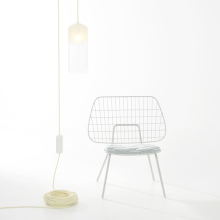Roet by Jetske Visser
December 8th, 2011 Posted In:Design
Exhibitions and Events Tags:
Design Academy Eindhoven
Dutch Invertuals
Jetske Visser
Netherlands
Roet
Soot
Textiles
Photography by Boudewijn Bollmann
Soot is an essential element for life and, at the same time, one of the main causes of the greenhouse effect. Fascinated by this powerful material, Dutch designer Jetske Visser set about creating a range of textiles that could put this waste material to use in a positive way. By collecting the layers of soot created by burning oil inside a lamp, Visser was able to use it as a pigment with which to dye fabric. The result is a series of textiles called Roet (Meaning soot in Dutch). The intensity of the colour is determined by the number of hours the lamp burns and the strength of the fixative used.
Photography by Boudewijn Bollmann
The project is not Jetske’s first exploration of environmentally friendly production methods for the textile industry. For her graduation project at Design Academy Eindhoven last year, Jetske used waste and residues from local industries together with the natural materials to develop yarns, pigments and techniques for textile production.
Photography by Boudewijn Bollmann
The Roet project was shown during Dutch Design Week as part of an exhibition called Untouchables by young design collective, Dutch Invertuals. The exhibition showcased a series of design responses to the prevailing spirit of insecurity of our times and the downside of freedom.
- A.Morris


Leave a Reply